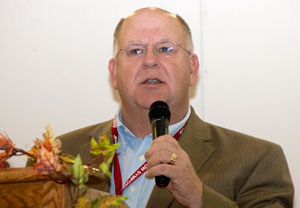Global Beef Market Opportunities
by Kindra Gordon for Angus Productions Inc.
MITCHELL, Neb. (Nov. 30, 2011) — “Opportunities are out there in front of you,” Paul Clayton with the U.S. Meat Export Federation (USMEF) said as he addressed cattle producers at the 22nd Range Beef Cow Symposium Nov. 29-Dec. 1 in Mitchell, Neb. Clayton followed that by asking producers to think about beef market globalization.

Paul Clayton
“In my mind that is about doing business by trading in the best market you can find," he said. "In a lot of cases for beef that is outside the U.S.” In 2011 alone, the United States is reporting 19% growth in beef exports.
He pointed to the world’s growing population — projected to grow by 1 billion people during the next 20 years — and the world’s growing economy. Clayton stated, “Countries are going to be growing and growing — and they have the ability to pay for things. There is value in these international markets.”
Clayton said Taiwan, Japan, Korea and the European Union have been our beef export focus in the past. While that will continue, he said Mexico, Russia and China have huge potential because of their populations, increasing gross domestic product (GDP) and friendly trade relations with the United States.
Clayton admitted that the Dec. 2003 incident of bovine spongiform encephalopathy (BSE) in the United States “destroyed” the American beef industry internationally.
“We have recovered, and faster than expected,” he stated. “Exports do contribute to higher cattle prices.”
Looking forward to 2012 and 2013, Clayton anticipates continued strong export growth. He said U.S. beef is in demand because it is grain-fed and quality genetics, has a reputation for high food safety standards and offers a consistent supply. He shared that many of the countries the United States competes against for exports provide primarily grass-fed beef, so supply for them is a challenge.
For the future, Clayton anticipates the United States will remain a leading supplier of red meat to the world. But to do so, he emphasized the need for the U.S. industry to continue being proactive on foreign animal disease control, address residue and growth promotant concerns, and be cognizant of foodborne illness risks and animal welfare concerns.
Traceability needs to be considered, Clayton stressed. “We are behind, and our competitors use it against us.”
While Japan may eventually relax its requirement for beef younger than 20 months of age, Clayton suggests the U.S. industry continue to verify source and age. He says, “It’s a way for us to diversify even more to add value.”
Regarding access to China, Clayton said he anticipates it could be a couple more years.
“When they do open up, it will be a good market for U.S. beef,” he added.
Lastly, Clayton encouraged American beef producers to continue to market through brands that help “tell a story” about U.S. beef production.
“Foreign consumers love cowboy hats and your horses," he said. "They love cowboys; they are intrigued by you.”
To see Clayton's PowerPoint presentation, click here.
The biennial Range Beef Cow Symposium was hosted Nov. 29-Dec. 1 at the Mitchell Events Center, Mitchell, Neb., by the cooperative extension and animal science departments of the University of Nebraska-Lincoln, South Dakota State University, Colorado State University and the University of Wyoming. Comprehensive coverage of the event is provided online at www.rangebeefcow.com, an event coverage site provided by Angus Productions Inc. (API), publisher of the Angus Journal and the Angus Beef Bulletin.
Editor’s Note: API's coverage of the event is made available for distribution to all media via an agreement with the Range Beef Cow Symposium Committee and API. Headquartered in Saint Joseph, Mo., API publishes the Angus Journal, the Angus Beef Bulletin, the Angus Beef Bulletin EXTRA, and the Angus e-List, as well as providing online coverage of events and topics pertinent to cattlemen through the API Virtual Library. For questions about this site, or to notifiy us of broken links, click here.

